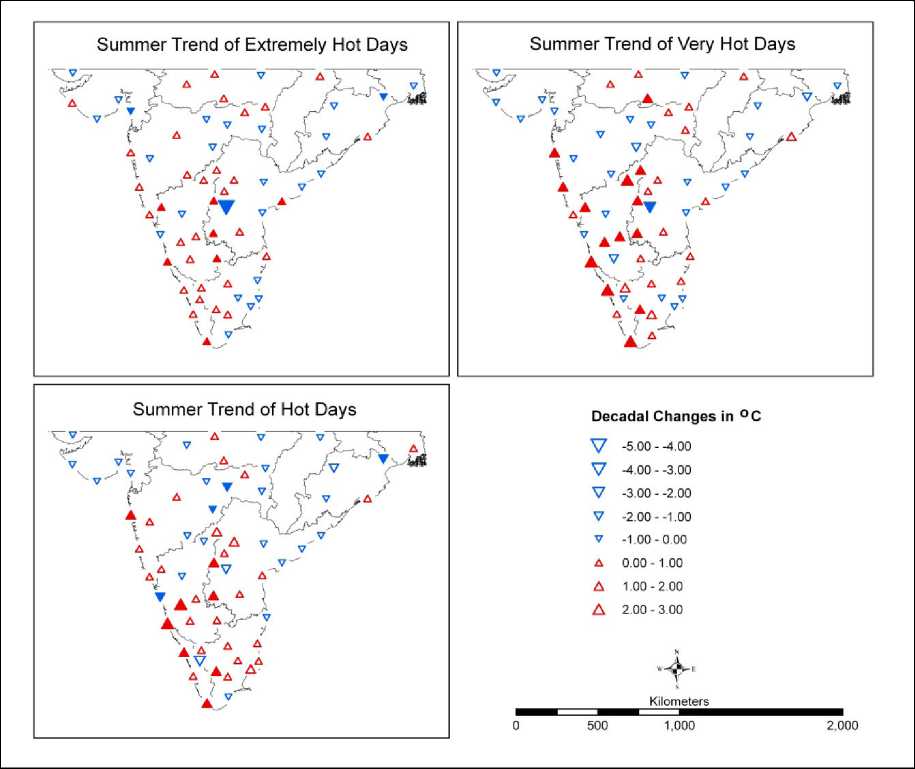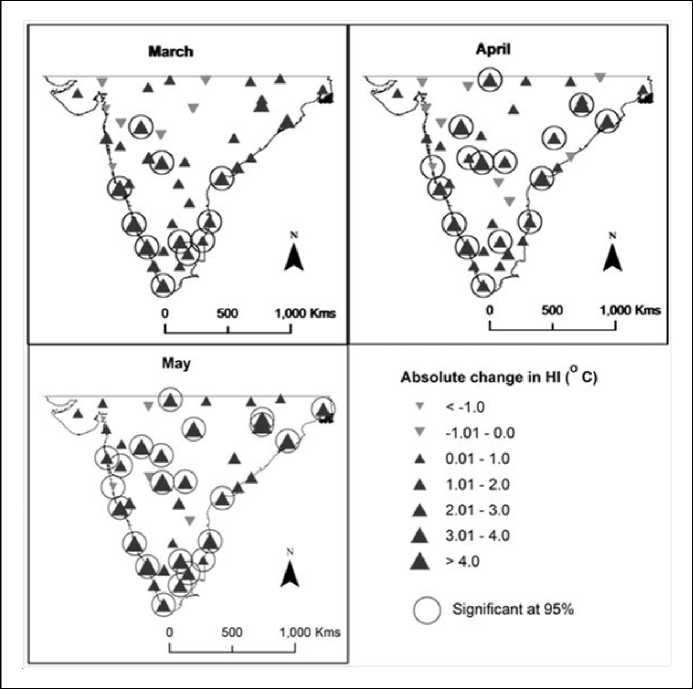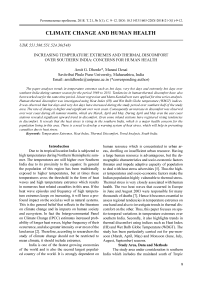Increasing temperature extremes and thermal discomfort over Southern India: concerns for human health
Автор: Dhorde Amit G.
Журнал: Региональные проблемы @regionalnye-problemy
Рубрика: Climate change and human health
Статья в выпуске: 3-1 т.21, 2018 года.
Бесплатный доступ
The paper analyses trends in temperature extremes such as hot days, very hot days and extremely hot days over southern India during summer season for the period 1969 to 2015. Tendencies in human thermal discomfort have also been worked out for the same time period. Linear regression and Mann-Kendall test were applied for time series analysis. Human thermal discomfort was investigated using Heat Index (HI) and Wet Bulb Globe temperature (WBGT) indices. It was observed that hot days and very hot days have increased during the study period over southern half of the study area. The rate of change is higher and significant over west coast. Consequently an increase in discomfort was observed over west coast during all summer months, which are March, April and May. During April and May even the east coast stations revealed significant upward trend in discomfort. Even some inland stations have registered rising tendencies in discomfort. It reveals that the heat stress is rising in the southern India, which is a major health concern for the population living in this area. There is a need to develop a warning system of heat stress, which will help in preventing casualties due to heat stress.
Temperature extremes, heat index, thermal discomfort, trend analysis, south india
Короткий адрес: https://sciup.org/143165326
IDR: 143165326 | УДК: 551.586:551.524.36(548) | DOI: 10.31433/1605-220X-2018-21-3(1)-9-12
Текст научной статьи Increasing temperature extremes and thermal discomfort over Southern India: concerns for human health
Due to its tropical location India is subjected to high temperatures during Northern Hemispheric summer. The temperatures are still higher over Southern India due to its proximity to the equator. In general the population of this region has been traditionally exposed to higher temperatures, but at times these temperatures cross the threshold in the form of heat waves and high temperature extremes which results in numerous heat related casualties in this area. If the heat wave episodes and frequency of high temperature extremes keeps on increasing, it will have a profound impact on the social as well as natural systems. This is the general belief that reflects in the literature on climate change and its impacts on human society and ecosystem. In fact the Intergovernmental Panel on Climate Change (IPCC) estimates increased probability of longer heat waves, higher frequency of their occurrence, and also greater intensity over most of the land areas [2]. Therefore, according to researchers the study of climate change should not be restricted to mean climate, it should include extremes.
India is one of the fastest growing economies of the world and is also the second largest populated country of the world. It is strongly dependent on human resource which is concentrated in urban areas, dwelling on insufficient urban resource. Having a large human resource is advantageous, but the demographic characteristics and socio-economic factors threaten and impede adaptive capacity of population to deal with heat stress adversities [5]. Thus the higher temperatures and socio-economic factors make the Indian population highly vulnerable to thermal stress. Thermal stress is very closely associated with human health. The two heat waves that occurred in Europe in June and August 2003 were responsible for many thousands of deaths [7]. Hence it becomes essential to assess regional tendencies in temperature extremes on one hand and also to investigate trends in thermal discomfort on the other. Thus, this paper focuses on spatio-temporal variations in temperature extremes over southern India. Secondly, it also highlights trends in thermal discomfort using indices such as Heat Index (HI) and Wet Bulb Globe Temperature (WBGT). The study has been particularly carried out for pre-monsoon (March, April, May) and Monsoon (June, July, August, September) seasons.
Study Area, Data and Methods
The study area under consideration is southern India which includes the mainland south of Tropic of Cancer. For thermal discomfort analysis 41 urban weather stations were selected based on the availability of data and its homogeneity. For the analysis of temperature extremes 62 weather stations of southern India were considered. The area has tropical wet and dry climate. It is a typical monsoonal climate. Wet period is confined to southwest monsoon season (June to September) over most of the peninsular region, whereas eastern coastal region experiences wet season during northeast monsoon season (October to December). The central part of Indian peninsular region receives meagre rainfall and thus is subjected to hot and dry climate. Summer season is marked by scorching heat and commencement of monsoon leads to muggy, sultry weather conditions. Thus, during monsoon season transition from hot summer to humid monsoon with intermittent breaks apparently builds heat stress pertaining to tropical hot temperature and high atmospheric humidity.
The data required for the study were obtained from National Data Center (NDC) of India Meteorological Department (IMD). For the assessment of temperature extremes daily data of maximum temperature (TMAX) was collected. For discomfort indices along with TMAX data for daily minimum temperature (TMIN), dry bulb temperature (DBT), wet bulb temperature (WBT), dew point temperature (DPT), relative humidity (RH), wind speed (WS) and vapour pressure (VP) was obtained for the period 1969–2015.
Hot extremes were defined based on the percentiles. A hot day was defined as a day when maximum temperature value remained between 90th and 95th percentile. A very hot day was defined when the TMAX value remained between 95th and 99th percentile and extremely hot day was defined when TMAX remained above 99th percentile. The analysis of human thermal comfort/discomfort was carried out using Heat Index (HI) and Wet Bulb Globe temperature (WBGT) indices. HI is a direct index which is based on direct measurements of environmental variables. It is also known as apparent temperature and was proposed by Steadman [6]. WBGT is one of the empirical indices based on objective strain response data obtained on individuals and group of individuals exposed to various levels and combinations of environmental and metabolic heat stress factors [3]. A time series was constructed for HI, WBGT, and temperature extremes which was then analysed using linear regression. Statistical significance of the obtained trends was tested with students t-test for 95% of confidence level (0.05 significance level). The significance was double checked with Mann-Kendall rank test.
Results and Discussion
“Extremes in temperature are characterized by daily temperature level exceeding tolerable limits, and their frequency and spell duration are of great interest in terms of human impacts” [4]. The limits here have been defined using percentiles. The lower limit of the percentiles taken was 90th percentile going up to 99th percentile. The rate of change obtained through linear regression was converted to decadal trend. Majority of the stations indicated rising tendencies in hot days, very hot days and extremely hot days (Figure 1). Higher number of significant trends were observed in hot days and very hot days. For hot days it was observed that the cities located in south have registered higher rates indicating that hot days and very hot days are increasing swiftly over this region. Another significant finding indicated faster rate among the west coast cities. This also includes the city of Mumbai, commercial and economic capital of India. Faster rates were also observed in the interior. Extremely hot days are on the rise but with few significant trends. Revadekar et al. [4] considered 121 stations for whole of India. They also observed the tendency of Indian region towards a warmer climate and increased frequency of warm events during 1971–2003. Further they found association of these events with El Niño and La Niña events. Another study carried out at the Department of Geography, Savitribai Phule Pune University found rising sea surface temperatures near the west coast of southern India.
To get a detailed picture thermal discomfort analysis was carried out at monthly scale. Initially heat index was computed for 41 urban centers of southern India. The rate of change in case of heat index was converted to absolute change seen over the study period, which is 46 years. The maps obtained are illustrated in Figure 2. During March it was observed that the cities over the southern tip indicate very high rate of increase in HI which is statistically significant. At some of the west coast stations the rate is more than 4 °C which is alarming. The northeastern region of the study area registered increase in HI but the trends were not significant. The southern stations of the east coast experienced significant increase than northern stations.
During April the increase in HI is more or less uniform over southern India. Over central area the rise is about 2–4°C over some locations. Similar rates are observed over northeastern locations, but the rise is now significant over here which was not the case in March. The magnitude of increase is again higher over west coast with one exception that is of the city Ratnagiri. The level of urbanization in this city is

Figure 1. Decadal trends in hot days, very hot days and extremely hot days during summer (Note: hollow triangles indicate insignifi cant trends and fi lled triangles indicate signifi cant trends. Upward pointing triangles show positive trends)
low, the population increase is not rapid, there is no in migration in the city which has lead to slow development of the city. During the month of May only four stations indicated decrease in HI, whereas all others indicated rise in HI with majority of them registering significant rising trends. The highest magnitude of increase is observed is again observed at the coastal locations. One of the common features in the west and east coast stations is that the stations on both the coasts show upward trend and more than 70% are significant trends. During May temperatures are very high over most of the southern India. At times the central and eastern parts of the study area are subjected to heat waves. Similar results were obtained for WBGT. The hot days and very hot days are increasing over west coast (Figure 1). Moisture from the adjoining seas is also brought inland by the local winds. Increasing HI is the result of increasing temperatures whereas individual analysis of some stations indicated increase in RH also.
Conclusion
There is no doubt that the temperature extremes over southern India are increasing. On the other hand, the cities of south India are urbanizing very fast. It includes cities such as Mumbai, Pune, Bengaluru, Chennai, Kolkata, Hyderabad which are among the top drivers of Indian economy. The unskilled and moderately skilled population which earns wages by working in the outdoor environment is exposed to high heat stress / thermal discomfort which are also increasing in majority of the cities. Besides this people have to travel long distances in the cities from their home to the work place which increases their risk of exposure to high heat stress. The eastern and western coasts are attractive tourist destinations for the people living inland. Therefore, these coasts are visited by millions of tourists even during summers. The rates observed in the rising HI are alarming and indicate detrimental consequences for the population that is exposed to such a high heat stress. It is there-

Figure 2. Absolute change in Heat Index (HI) during summer months
fore necessary to develop a warning system for the people which would help them to take adaptive and preventive measures during the high thermal discomfort days. Every year hundreds of lives are lost due to thermal stress during summer months. Thus, the increasing thermal discomfort over southern India is a major concern with respect to the health of the citizens. Another consequence will be on the cooling energy demand. Due to increasing thermal discomfort the energy demand will increase and this will put extra pressure on south Indian states which are already facing power shortage.
Список литературы Increasing temperature extremes and thermal discomfort over Southern India: concerns for human health
- Diaz J, Garcia-Herrera R, Trigo RM, Linares C, Valente MA, De Miguel JM, Hernandez E (2006) The impact of summer 2003 heat wave in Iberia. Int J Biometeorol 46: 145-149
- IPCC (2012) Managing the risk of extreme events and disasters to advance climate change adaptation. In: Field CB, V Barros, TF Stocker, D Qin, DJ Dokken, KL Ebi, MD Mastrandrea, KJ Mach, GK Plattner, SK Allen, M Tignor, and PM Midgley (Eds.) A special report of Working Groups I and II of the Intergovernmental Panel on Climate Change. Cambridge University Press, Cambridge, UK, and New York, NY, USA, pp 582
- National Institute of Occupational Safety and Health (NIOSH) (1986) Occupational exposure to hot environments. http://www.cdc.gov/niosh/docs/86-113/86-113.pdf
- Revadekar JV, Borgaonkar HP, Kothawale DR (2010) Temperature extremes over India and their relationship with El Nino-southern oscillation. In Natural and Anthropogenic Disasters: Vulnerability, Preparedness and Mitigation, Jha MK (Ed.), Springer, 275-292
- Smoyer KE, Rainham DGC, Hewko JN (2000) Heat-stress-related mortality in five cities in Southern Ontario: 1980-1996. Int J Biometeorol 44: 190-197
- Steadman RG (1979) The assessment of sultriness Part I: A temperature-humidity index based on human physiology and clothing science. J Appl Meteorol 18:861-885
- WHO (2003) The health impacts of 2003 summer heat waves -Briefing note for the Delegations of the 53rd session of the WHO Regional Committee for Europe, 8 Sept 2003, Vienna


